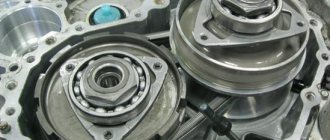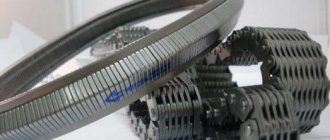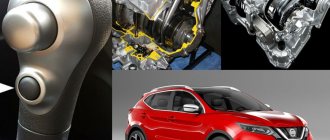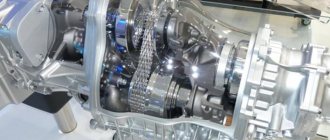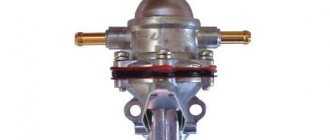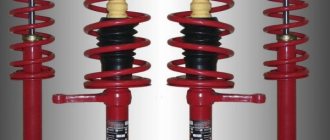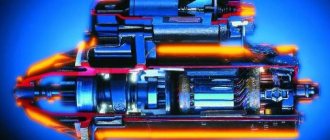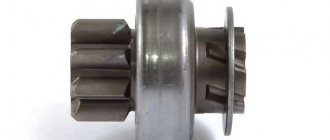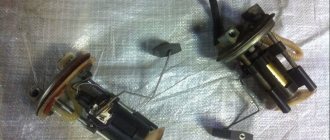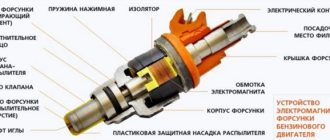The mid-size Japanese crossover Nissan Murano is represented on the car market in three generations. Powerful car engines are combined with Xtronic CVT transmission. Depending on the generation, cars are equipped with CVTs that have design differences. The units are characterized by smooth running, provide good acceleration dynamics and allow economical fuel consumption. High performance and a balance of comfort are achieved by minimizing the coefficient of friction of components and expanding the range of gear ratios.
| Crossover generation | Year of issue | Engine capacity | type of drive |
| Nissan Murano Z50 | 2002-2007 | 3.5 l | front/full |
| Nissan Murano Z51 | 2007-2016 | 2.5 l | front/full |
| Nissan Murano Z52 | since 2016 | V6 3.5 l | full |
Despite the high reliability of Xtronic CVT, they are susceptible to malfunctions, which can be eliminated by repairing the variator. Breakdowns occur mainly due to natural wear and tear with a high mileage of the crossover and a small residual working life, as well as due to illiterate operation, untimely maintenance and driving at maximum load.
CVT transmissions are technologically advanced units and if a breakdown occurs, they require qualified diagnostics and competent repairs using modern equipment. This is what the experienced craftsmen in our service specialize in.
Signs of trouble
Noise and rattle
The reason is wear of the bearings on which the cones rotate. And, even worse, wear of the seats of these bearings. Both low-quality bearings and a loose fit are a manufacturing defect. Sometimes it can be fixed under warranty. If the warranty has expired, only complete disassembly and troubleshooting will save you.
You shouldn’t delay repairs for a long time: wear products spread throughout the variator and damage all its components.
Jerks during acceleration
They indicate instability of the control pressure. The pressure reducing valve is responsible for regulating the pressure created by the hydraulic pump. Metal shavings cause it to hang, and the pressure of the working fluid becomes unstable. But it controls the compression of the cones.
Switching to emergency mode
If significant deficiencies are detected, the control unit switches the variator to emergency mode. If after restarting the engine the car can be driven, then the reason is most likely a malfunction of the control electronics.
Complete immobilization of the car
A situation when the variator suddenly stops transmitting torque: the engine roars, but the car does not move. The most likely cause is a broken steel belt. Here you need to call a tow truck.
Jerks in all modes
Bearing wear and problems with the pressure reduction valve gradually damage the belt and cones - the most expensive and important elements of the variator. Belt slippage caused by scuffing on the working surfaces is manifested by twitching in all driving modes. Repair of the variator in this case consists of replacing the cones and belt. Sometimes it is possible to grind the cones, but the belt will have to be replaced in any case.
Diagnosis of CVT Nissan Murano
To check the operation of the control unit, as well as the presence of error codes, a special scanner is used. Diagnostics are performed without disassembling the unit. The cause of breakdown, incorrect operation and the need to repair the control unit is often moisture that gets onto the electronics through a violation of the seal of the housing.
The mechanical part is checked by opening the variator. The car is raised on a lift, the transmission oil is partially drained and the crankcase is dismantled. Visual inspection identifies microcracks and mechanical damage to parts (assemblies). If defects are identified, the Nissan Murano variator is repaired.
What if you handle it with care?
This variator became the next link behind the very reliable units of the first generation (RE0F06A), which we did not see - of course, with the exception of those who brought right-hand drive cars from Japan. Its descendant, JF016, is now installed on many cars, and it is considered more capricious and unreliable.
With proper operation, the Jatco JF011 variator runs for a long time: problem-free runs of up to 180,000 km are known.
The main thing is not to overload the variator, change the working fluid every 45,000 km and contact specialists at the first sign of a malfunction. CVT repair is not a cheap operation. But usually it costs no more to repair it than a hydromechanical automatic machine.
Source
DIY repair
Repair of the Nissan Murano variator in Yekaterinburg, Chita, Sevastopol, etc. is quite expensive. Therefore, many drivers decide to diagnose and replace them themselves. This is quite a responsible procedure. However, knowing how such an event is carried out, you can significantly save money on the family budget.
Before carrying out diagnostics and repairs, you will need to purchase the necessary tools and equipment. In some cases, repairing the variator will be quite simple. However, for a driver who has not encountered a similar task and has no idea about the CVT device, this will be a rather difficult task.
You will first need to consider the design of the variator of the presented model. This will allow you to identify faults that interfere with the stable operation of the system. Also, the owner of the Murano must have enough free time to carry out maintenance of this unit on his own.
CVT malfunctions
Structurally, variators are a system of two cone-shaped pulleys connected to each other by a belt drive. Each pulley contains a pair of cones directed towards each other, the mutual approach or distance of which during engine operation leads to a change in the radius of movement of the V-shaped closed belt or chain. Due to this, the change in gear ratio occurs smoothly.
What causes a variator to break down?
The main cause of known malfunctions of CVTs is violation of basic operating rules:
Additional causes of malfunctions can be various defects in structural components (defects, ill-conceived design, poor-quality connection), as well as natural physical wear and tear of the constituent elements, which manifests itself after 150,000 - 200,000 km.
CVT malfunctions can occur both in its electronic control module and in mechanical components.
Electronics defects
In the first case, detection of a specific breakdown is carried out using computer diagnostics. A diagnostic code is assigned to each defect. Thus it is easy to determine:
The probable cause of a defect in the electronics may also be a violation of the integrity of the electrical wiring or unreliable contact in the connector.
Mechanical problems
Computer diagnostic tools are not the only tools used to detect mechanical problems. In this case, it is necessary to approach the problem in a comprehensive manner and monitor the parameters of the working fluid, conduct road tests, read the diagnostic code, and clarify signs of malfunctions.
Fuel consumption
Fuel consumption in the Nissan Murano Z51, as in any other car, depends on the engine the vehicle is equipped with, the fuel used, the type of road (highway or city), and driving style.
However, the consumption figures stated by car manufacturers apply. This table shows mixed fuel consumption data (highway + city) for the most popular modifications of the Nissan Murano Z51.
| Engine volume, l | Fuel | Consumption per 100 km, l |
| 2.5 | Gasoline AI-95 | 8,6-9,1 |
| 2.5 | Diesel fuel | 8 |
| 3.5 | Gasoline AI-95 Gasoline AI-98 | 10.6 10.9 |
It is quite possible to reduce fuel consumption a little. To do this you will need:
- carry out timely diagnostics of all machine systems;
- monitor thermostat readings;
- monitor the readings of the coolant temperature sensor;
- Fuel your car only with high-quality fuel;
- develop a calm driving style;
- brake and move off smoothly.
It is especially important to follow all these rules in winter, otherwise fuel consumption will be too high, which will naturally make driving the Nissan Murano Z51 uncomfortable.
Detection of defects by external manifestations
Many variator malfunctions can be identified by characteristic external manifestations, but such “diagnosis” has one significant drawback - the manifestation of different defects may be the same. This is reflected in the table below.
| External manifestation | Problems |
| There is no movement; weak dynamics (slippage) | · breakdown of the main clutch; · defective variator transmission; · torque converter problems; · breakdown of the electro-hydraulic system; · problems with the control module. |
| Push when changing neutral to D (R); intermittent movement | · breakdown of the pressure solenoid valve in the main line; · problems with the control module |
| The car is moving in neutral | · the gear selector is faulty; · problems with the control module; · defective wiring or connectors. |
| Manual gear shift does not function | · problems with the control module; ·damaged electrical wiring or connector contacts; The gear selector is faulty. |
The most serious and materially costly defect of the above is the defect of the variator transmission. It occurs when the belt slips between the pulley cones with the simultaneous formation of scoring at the ends of the belt segments and the working surfaces of the cones. This problem can only be eliminated by complete replacement.
Installing an additional radiator
There are situations when an old or restored Nissan Murano radiator cannot cope with cooling the variator. In this case, you need to install an additional element that provides better heat dissipation.
Algorithm of actions:
- Removing the front part of the hood in front of the main radiator.
- Fastening an additional radiator using special clamps.
- Connecting tubes to the input and output.
- System testing.
Bearing wear
This is the most common defect in CVT cones. It manifests itself with a characteristic hum after a run of at least 50,000 km.
The belt is assembled from numerous plates interconnected by steel constrictions. With its side surfaces, with subtle oblique notches applied to improve adhesion, it comes into contact with the pulley cones. During operation, the notches wear out, which can ultimately lead to serious damage. Therefore, even the elimination of humming bearings should be accompanied by a preventive replacement of the belt, which guarantees the preservation of serviceable pulleys.
Bearing noise can also occur for several other reasons:
There is no consensus among manufacturers on this issue. For example, Mitsubishi strongly recommends changing the oil every 75,000 km, while Renault-Nissan only allows monitoring its level and condition during the warranty period (100,000 km).
CVT oil is marked with the abbreviation CVT. Every car manufacturer has such oil. The original composition from Nissan is produced under the symbol NS-2. Mitsubishi is promoting the DiaQueen CVT-J1. The analogue from Renault is known as ELFMATIC CVT. Honda produces HMMF and CVT-F, VAG produces ATF CVT. All these fluids are recommended specifically for CVTs. It is absolutely unacceptable to use oils intended for hydromechanical automatic transmissions.
The amount of oil required for filling is determined by the type of drive and power unit. For example, for a front-wheel drive Qashqai with a 2-liter engine not equipped with an oil cooler, approximately 4.2 liters are required. A couple of liters will “get stuck” between the transformer elements and the hydraulic system components, since it is impossible to pump out these “drops” using the standard draining procedure. To completely renew the filling, they use the replacement method, using an appropriate installation and three times the volume of working fluid.
Smooth ride
The next most common defect occurs in the form of jerking and jerking of the car. The responsibility lies with the pressure reducing valve located in the oil pump.
The latter begins to function when the engine starts. The pump is manufactured as a monolithic unit and in the event of a defect in the pressure relief valve, it must be completely replaced. During normal operation, the valve should move freely in a mating sleeve pressed into the pump housing. Constant contact of the valve working surface with abrasive particles of wear products falling on it leads to the formation of many longitudinal scratches. When worn, the valve begins to jam so much that subsequently it is difficult to pull it out even with pliers.
The result is abnormal pressure, leading to disruption of the coordinated operation of the pulleys. This causes the belt to slip. Timely contacting the service allows you to reduce financial costs. Minor damage to the cones can be corrected by grinding. The belt must be replaced.
The most famous CVT oil sold in car dealerships is the product from Nissan NS-2 in a two-liter tin. The container of the new issue is silver, the old one is painted blue. In no case should it be confused with the old, completely incompatible NS-1 oil, bottled in pink containers.
Extreme enthusiasts who are accustomed to pulling out a stuck car by rocking with instant alternate switching of the lever from position D to R and back run the risk of encountering another problem - unpleasant jolts during the process of switching from the “parking” position to D or R. In this mode, there is practically no pause when switching. between positions D and R, although ideally a complete stop of the car is required. As a result, increased wear of the coupling spline joints inside the planetary gear in contact with the friction discs occurs. The result is the need to replace the planetary gears.
Preparatory work
Before you begin repairing the Nissan Murano Z51, Z50 variator, you should properly disassemble the mechanism. To do this, experts recommend carefully studying the manufacturer’s instructions. If the driver understands that any of the listed operations is very difficult for him, it is better to entrust this work to a professional.
For those who decide to carry out the CVT repair process on their own, you need to carry out proper preparation before starting to dismantle the transmission. You will need to prepare the appropriate tools. To do this, you need to purchase a set of keys, screwdrivers, clamps, and a hammer. All tools need to be laid out on the work table.
You should also prepare containers in which the removed parts will be placed. It is better to arrange the jars in a row. This will make it easier to remember the sequence. If necessary, containers can be numbered. It is also advisable to take photographs of the transmission during the disassembly process. This will help you assemble it correctly in the future.
Thermal mode
The temperature regime in CVTs should be observed especially carefully. This function is assigned to the self-diagnosis system and is carried out using a temperature sensor. If the limit value is exceeded, a fault signal lights up on the dashboard with the simultaneous transition of the variator to an emergency state.
In order to ensure optimal oil temperature, on most cars, in addition to the main heat exchanger, another radiator is connected. It is mounted in the front area of the engine compartment up to the climate system condenser. Through the air ducts located in the bumper, it is often clogged with various debris - poplar fluff, leaves, dirt, gravel, midges, etc. The first manifestation of its critical contamination is severe overheating when traveling at high speeds. Once every two years it is necessary to clean and wash it very thoroughly. It's best to have the bumper disconnected. It is also recommended to cover the external entrances of the air ducts with protective nets, since the radiator is susceptible to damage from anything that flies from under the wheels.
According to the collected statistical data, failures of variators occur no more often than failures of hydromechanical units. Even the most cautious manufacturers, who were previously quite skeptical about the reliability of CVTs, began to use them in the power units of their popular models. For example, Toyota - on the restyled RAV4, Subaru - on Forester, XV and Outback. The owners of this brand can hardly be called slow drivers. Constant driving over rough terrain and powerful accelerations were recently considered unacceptable for the operation of CVTs. It seems that times are changing, so the prospects are brighter for them.
Source
Continued dismantling
Repair of the Nissan Murano variator can only be performed with the systematic dismantling of all components of this unit. After the procedures have been completed, you will need to remove the remaining components of the system. The oil pump is covered with a cover. It will also need to be dismantled. Next you can remove the pulley.
You will also need to unscrew the bolts on the back side of the variator. They hold another lid. In this case, you will need to use a screwdriver. The strap must also be removed. This is done using clamps. The shafts with the belt will also need to be removed.
The pulleys will need to be installed on a flat, horizontal surface. This completes the disassembly process.
How to determine that the variator is about to break
The most common problem with a variator is the failure of the bearings of its pulleys. This is expressed in a characteristic hum, which even servicemen often mistake for the noise of worn-out wheel bearings. The complexity of diagnostics is aggravated by the fact that bearings in a variator can “fly” at 50,000 km or 200,000 km. It all depends on the specific car model and the owner’s driving style.
The main enemy of this unit is metal dust generated during normal operation of the variator. After all, its chain and pulleys are constantly in the process of rubbing against each other and therefore inevitably slowly wear down. The products of such wear enter the oil of the variator lubrication system, and from there to the bearings. To capture this steel “powder,” the design includes oil filters and magnets. But neither they, nor even the oil change intervals reduced relative to those recommended by the manufacturer (from 100,000 km to 50,000) in the variator do not save from metal dust in it. In addition, a number of experts associate the “lottery” with the life span of the support bearings of the variator pulleys with the instability of their quality. So owners of used cars with this type of transmission have to constantly listen to what is happening in it.
Another fairly common malfunction of the variator is problems with the oil pump. The same metal dust from wear gets into its valves, causing them to jam. Because of this, the oil pressure in the system begins to jump, the consistency of the movement of the pulleys disappears, the belt slips, and for this reason the car jerks while driving. Both the belt and the pulleys do not like this kind of treatment at all, and if the process is started, the car owner will soon have to look for a new box.
Having mentioned the belt, we cannot help but mention problems with wear of the belt itself. It consists of many intricately shaped metal plates mounted on a bunch of steel strips. For better adhesion to the pulleys, microroughness is applied to their surface. Over time, the latter are erased, turning into that same ill-fated metal dust. At the same time, the belt begins to slip, jerking the car and informing the owner that an urgent opening of the variator is required.
Source
Motors
Common problems
All cars have very weak radiators: leaks, swelling and loss of honeycombs are typical problems for them even with relatively short mileage. Experienced car owners sometimes managed to change a couple of radiators during operation.
There are also a lot of problems with the wiring of the motors, the wiring connectors are poorly sealed, and in places of greatest heating the wiring cracks even on motors of the latest years of production, and during any work you need to be extremely careful so as not to cause a short circuit.
Gasoline engines
In fact, the only engine on the Murano is the VQ35DE with 3.5 liters and 231/265 horsepower, which is often presented as almost the best engine of our time. Among the undoubted advantages, it is necessary to note the excellent weight and size indicators and power: only 140 kilograms for an engine with a power of 230-280 horsepower - this is an excellent indicator. The service life of the piston group on many cars with it exceeds 300 thousand kilometers; there are also examples of mileages under a million.
It is very rare to find a car with a QR25DE engine of 2.5 liters and 170 horsepower. This is an inline-four, and it is better known from Nissan cars and light crossovers. She is rarely praised because she has many shortcomings. But compared to the 2.5-liter YD25DDT diesel engine with 190 horsepower, which in theory was found on European cars, the 2.5 gasoline engine is not bad at all - the diesel engine has very problematic bearings, and it performed poorly on the Navara and other Pathfinders.
What is good about V6 3.5, I have already written. Compact aluminum block, cast iron liners, timing chain drive of a very successful design and maximum use of plastic in the design. In general, a combination of healthy conservatism and modern weight loss trends. The motor is a further development of the VQ line of engines and a modernization of the earlier 3.0 VQ30DE engines, which, in turn, go back in design to the VE30, and the design is very well developed.
The chains are quite reliable, they last about 200 thousand kilometers, the Americans manage to reach 350, but we have not seen such record holders. The tensioner is quite reliable, and chain wear is visible: 4-5 tooth offset means a new chain, and about 12 means an urgent replacement.
The service life of the piston group is also excellent - see above. There is even one standard repair size, and aftermarket pistons come in two more. True, you need to sharpen the liners carefully - there is very little “meat” between the cylinders. And fuel consumption is not bad; in later cars with a CVT you can get 11-13 liters in the city.
Unfortunately, there were some shortcomings. The first weak point is the catalysts and wiring. Any ignition failures and disturbances in mixture formation lead to cracking of the catalysts, which partially blows them into the cylinders. In general, Nissan’s favorite problem, from which thousands of Almeras and Tiidas suffered, also exists in Murano. Only the cost of overhauling a large engine is almost three times higher. It is better to cut off the catalysts in advance, and even better to replace them with normal sports wheels on a metal (not ceramic) base that can withstand fluctuations in mixture formation.
The second problem is closely related to the first. On the one hand, regularly deposited oil scraper rings lead to the rapid death of catalysts, and on the other, a dusty catalyst instantly finishes off the piston group, with scuffing of the liner and piston, as well as severe wear of the compression rings. And this is clearly visible precisely in compression.
Additional reasons for oil consumption are overheating of the outer cylinders: the engine is extremely sensitive to the quality and timing of antifreeze replacement, the cleanliness of the radiators and the pump; with simplified Chinese ones, the fifth cylinder can heat up on a fully functional engine. Any overheating leads to accelerated degradation of the plastic of valve covers and spark plug well seals. The caps don’t warp so often, but the spark plug well seal is nominally non-replaceable, it is assumed that the cap needs to be replaced at a cost of 11-15 thousand rubles. In practice, they use a crown to drill out the inner plate of the cover and install an oil seal from Toyota; they have just the right one, with a seal.
You also need to regularly change the crankcase ventilation valve (CVV), it is made separately, without a membrane and “fungus”, and, suddenly, it comes from Hyundai - according to reviews, the original from the Koreans is cheaper and better than the Japanese one. A non-working VCG, in addition to oil loss, causes a drop in traction, leaks and detonation, so monitoring its condition on this engine is very important.
Phase shifter 3.5
21,517 rubles
The cardboard gaskets of the phase regulator channels leak into the pan, which causes not oil consumption, but a drop in pressure. Cutting a high-quality gasket or buying a ready-made gasket is no longer a problem, but if the last time you climbed into the engine was 10 years ago, then surprises are possible in the form of gaskets made of tin and packaging cardboard in silicone sealant. A popular mistake is buying factory gaskets 13533-JK21A. They are not suitable for this motor, although they are similar in configuration.
Driving with oil leaks is fraught, especially if you use low-viscosity oil (5W30, for example). Here it can not only lift up the camshafts, but also the liners, and sometimes the shafts simply break, and the chains jump. Unfortunately, the engine does not show a drop in oil pressure until the last moment - there are no hydraulic compensators (the valves need to be adjusted every 50 thousand so as not to crumble) and there is nothing to click with. And the sensor, traditionally for Japanese cars, is chosen so that the malfunction light comes on when the “fist of friendship” has already knocked. By the way, replacing the oil pressure sensor with a 1 bar sensor is a very successful tuning for the engine.
Less serious problems usually result in increased fuel consumption and loss of traction. The motor is very sensitive to the state of the lambda, fortunately there is firmware “for Euro-2”, which disables two “extra” ones, which reduces the number of failures.
The intake manifold control system here is implemented quite interestingly, the drive is vacuum, but it is mainly the wiring and relay that let it down. I would like to note that the thermostat is not the most successful - it sticks infrequently, but there is a tendency for it to stick in the closed position, which can lead to overheating.
Air leaks at the intake are not always obvious; the engine is tightly packed into the engine compartment; many elements are difficult to check (but desirable).
Used motors are quite expensive, from 50 to 100 thousand depending on condition, which is not so cheap. The recommendations are simple: do not overheat, watch for leaks, and it is also advisable to pour oil with a viscosity of not 5W30, but a more viscous 10W40 or even 10W60.
| Detail | Original price | Non-original price | Non-original price 2 |
| Engine | |||
| Radiator 3.5 | 24 475 | Luzar 8 305 | Nissens 10 009 |
| Timing chain 3.5 | 4 603 | Febi 11 106 | TurboEngineering 2 341 |
| Phase shifter 3.5 | 21 517 | VPM 8 149 | Zikmar 10 370 |
| Small chain | 2 402 | Did 2 210 | TurboEngineering 3 371 |
| Timing kit | Out of stock | All4Motors 11 218 | Masuma 18 240 |
| Oil pump | 10 906 | ZZVF 6 151 | Sat 4 930 |
Nissan Teana 2010, petrol engine 2.5 liters, 186 hp. p., front-wheel drive, CVT — other
Cars for sale
Nissan Teana, 2013
Nissan Teana, 2011
Nissan Teana, 2012
general characteristics
Variable speed transmissions (CVT) are very popular today. They are installed in cars of different models. The presented transmission has a number of advantages. Therefore, this particular type of gearbox is installed in Nissan Murano models.
It should be noted that this brand puts three generations of cars on the market. The first model to be introduced to the market was the Z50. It was produced from 2002 to 2008. The second generation Z51 model also won worldwide recognition. This car is also in demand among Russian buyers. She debuted in 2007. Also on sale is the third generation of Nissan Murano - Z52.
Models Z50, Z51 Nissan Murano have a CVT, which is manufactured using the latest technologies. In used cars it needs repair or maintenance. Therefore, in our country, these types of lines are most often repaired. There is a wide selection of spare parts for sale for the first two generations of Murano CVTs.
